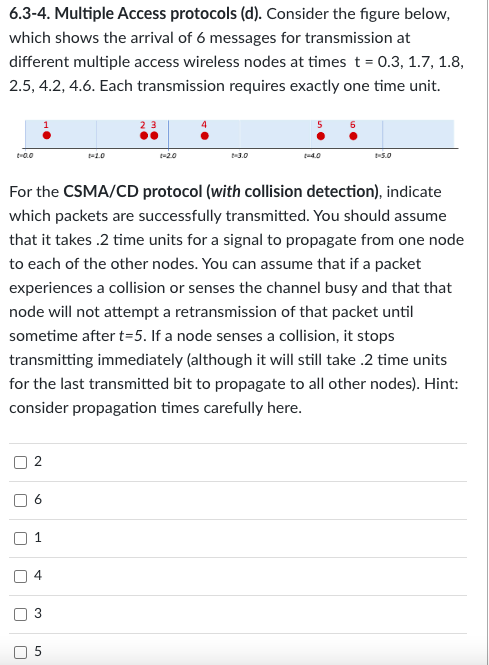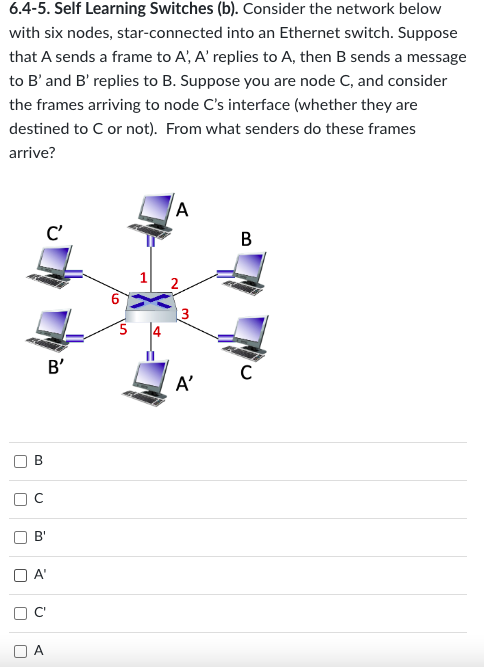6.3-4. Multiple Access protocols (d). Consider the figure below, which shows the arrival of 6 messages for transmission at different multiple access wireless nodes at times t = 0.3, 1.7, 1.8, 2.5, 4.2, 4.6. Each transmission requires exactly one time unit. 1.0.0 0 For the CSMA/CD protocol (with collision detection), indicate which packets are successfully transmitted. You should assume that it takes .2 time units for a signal to propagate from one node to each of the other nodes. You can assume that if a packet experiences a collision or senses the channel busy and that that node will not attempt a retransmission of that packet until sometime after t=5. If a node senses a collision, it stops transmitting immediately (although it will still take .2 time units for the last transmitted bit to propagate to all other nodes). Hint: consider propagation times carefully here. 2 1-2.0 4 1-5.0
6.3-4. Multiple Access protocols (d). Consider the figure below, which shows the arrival of 6 messages for transmission at different multiple access wireless nodes at times t = 0.3, 1.7, 1.8, 2.5, 4.2, 4.6. Each transmission requires exactly one time unit. 1.0.0 0 For the CSMA/CD protocol (with collision detection), indicate which packets are successfully transmitted. You should assume that it takes .2 time units for a signal to propagate from one node to each of the other nodes. You can assume that if a packet experiences a collision or senses the channel busy and that that node will not attempt a retransmission of that packet until sometime after t=5. If a node senses a collision, it stops transmitting immediately (although it will still take .2 time units for the last transmitted bit to propagate to all other nodes). Hint: consider propagation times carefully here. 2 1-2.0 4 1-5.0
Computer Networking: A Top-Down Approach (7th Edition)
7th Edition
ISBN:9780133594140
Author:James Kurose, Keith Ross
Publisher:James Kurose, Keith Ross
Chapter1: Computer Networks And The Internet
Section: Chapter Questions
Problem R1RQ: What is the difference between a host and an end system? List several different types of end...
Related questions
Question
please answer the qestions in the picture .

Transcribed Image Text:6.3-4. Multiple Access protocols (d). Consider the figure below,
which shows the arrival of 6 messages for transmission at
different multiple access wireless nodes at times t = 0.3, 1.7, 1.8,
2.5, 4.2, 4.6. Each transmission requires exactly one time unit.
t=0.0
For the CSMA/CD protocol (with collision detection), indicate
which packets are successfully transmitted. You should assume
that it takes .2 time units for a signal to propagate from one node
to each of the other nodes. You can assume that if a packet
experiences a collision or senses the channel busy and that that
node will not attempt a retransmission of that packet until
sometime after t=5. If a node senses a collision, it stops
transmitting immediately (although it will still take .2 time units
for the last transmitted bit to propagate to all other nodes). Hint:
consider propagation times carefully here.
|
n
r
U
2
6
1
4
3
1-4.0
5

Transcribed Image Text:6.4-5. Self Learning Switches (b). Consider the network below
with six nodes, star-connected into an Ethernet switch. Suppose
that A sends a frame to A', A' replies to A, then B sends a message
to B' and B' replies to B. Suppose you are node C, and consider
the frames arriving to node C's interface (whether they are
destined to C or not). From what senders do these frames
arrive?
U
|
B
J
с
C'
B'
OA'
OC
A
B'
A
2
A'
B
Expert Solution
This question has been solved!
Explore an expertly crafted, step-by-step solution for a thorough understanding of key concepts.
This is a popular solution!
Trending now
This is a popular solution!
Step by step
Solved in 4 steps

Recommended textbooks for you

Computer Networking: A Top-Down Approach (7th Edi…
Computer Engineering
ISBN:
9780133594140
Author:
James Kurose, Keith Ross
Publisher:
PEARSON

Computer Organization and Design MIPS Edition, Fi…
Computer Engineering
ISBN:
9780124077263
Author:
David A. Patterson, John L. Hennessy
Publisher:
Elsevier Science

Network+ Guide to Networks (MindTap Course List)
Computer Engineering
ISBN:
9781337569330
Author:
Jill West, Tamara Dean, Jean Andrews
Publisher:
Cengage Learning

Computer Networking: A Top-Down Approach (7th Edi…
Computer Engineering
ISBN:
9780133594140
Author:
James Kurose, Keith Ross
Publisher:
PEARSON

Computer Organization and Design MIPS Edition, Fi…
Computer Engineering
ISBN:
9780124077263
Author:
David A. Patterson, John L. Hennessy
Publisher:
Elsevier Science

Network+ Guide to Networks (MindTap Course List)
Computer Engineering
ISBN:
9781337569330
Author:
Jill West, Tamara Dean, Jean Andrews
Publisher:
Cengage Learning

Concepts of Database Management
Computer Engineering
ISBN:
9781337093422
Author:
Joy L. Starks, Philip J. Pratt, Mary Z. Last
Publisher:
Cengage Learning

Prelude to Programming
Computer Engineering
ISBN:
9780133750423
Author:
VENIT, Stewart
Publisher:
Pearson Education

Sc Business Data Communications and Networking, T…
Computer Engineering
ISBN:
9781119368830
Author:
FITZGERALD
Publisher:
WILEY